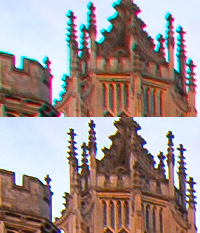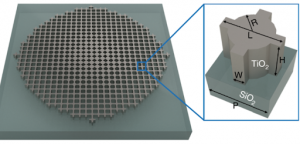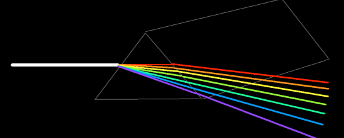By Yi Zhu
Ever wonder why rainbows contain, well…a rainbow of colors?
The science behind rainbows was first demonstrated by Isaac Newton in 1666 when he showed that white light passing through a glass prism will spread out into a wide spectrum of colors.

We observe a rainbow from materials such as a glass prism or a water droplet, (in the case of a “natural” rainbow,) because of a phenomenon known as chromatic aberration. Light of different wavelengths, which our eyes perceive as different colors, will bend by different amounts as they pass through optical material. Thus, sunlight, composed of light rays of all colors will separate into the component colors.
While chromatic aberration can be gorgeous to observe, it is also a menace in the world of optics. In devices such as cameras that wish to focus all colors of light onto a single point, chromatic aberration prevents a “perfect” image from forming. While many solutions have been proposed to reduce chromatic aberration in imaging systems, most are not ideal and require adding bulky optics and additional devices into the imaging system.
In an article published in Nature Communications, a team at UC Berkeley led by Professor Boubacar Kanté proposed a modern take on this century-old puzzle. Kante’s team designed and tested a new lens known as a fishnet-achromatic-metalens (FAM), capable of eliminating chromatic aberration across a wide spectrum of colors.
To understand how the FAM operates, we must first realize that we can predict how much light bends, or refracts, at the interface between two materials by knowing the change in the index of refraction between the two materials. The index of refraction depends on many properties of the material including the wavelength of light with which a material interacts. Thus, different colors of light striking an interface will bend different amounts because they will experience different changes in the indices of refraction.



The FAM overcomes these traditional limitations on the index of refraction of materials by utilizing a waveguide array. A waveguide is a structure, in this case, composed of TiO2, that has a tunable index of refraction depending on its geometry. For their FAM, Kanté’s team determined that in order to reduce chromatic aberration, the device requires light to interact with extremely small waveguides, about 350 nm in any direction, in the cross-sectional shape of a circle superimposed on a cross (image below). Furthermore, the cross-circle waveguides need to be arranged in an array reminiscent of the pattern of a fishnet.

After building a lens using nanofabrication, the team then tested it on a wide spectrum of light with different wavelengths, and found that the device is effective at eliminating chromatic aberration across the range of 640–1200 nm—notably, greater than the range of visible light, which is 380–740 nm. Furthermore, the authors report that this is the largest range measured to date for a lens of its type.
The success of the FAM is an exciting step in the field of metamaterials, or human-engineering materials, and paves the way for more efficient and effective optical devices. Furthermore, engineering techniques utilized by Kanté team can be applied to improve optics from the telescopes peering into the depths of space to the fiber-optics that form the backbone of the internet.
